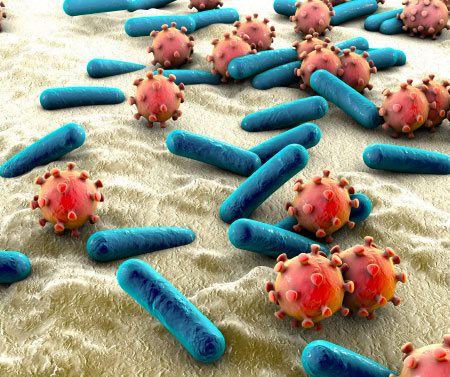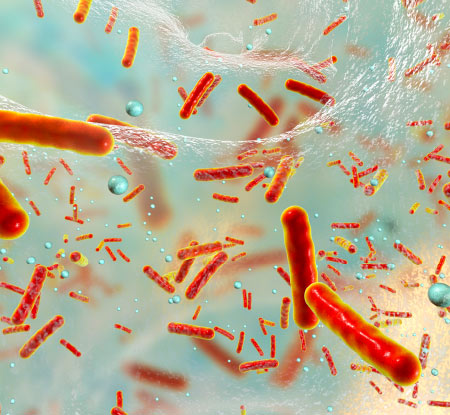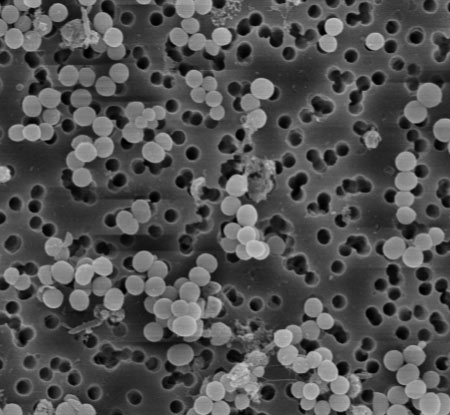Assess the mechanism of action, host response, activity, profiling and efficacy of your antimicrobials to fuel a pipeline of new drugs to benefit patients.
New agents displaying innovative chemistry and modes of action are desperately needed worldwide to tackle the public health menace posed by antimicrobial resistance. In the recent years, biological and technological advances have opened the door to a more accurate characterization of antimicrobials.
We propose both bespoke cutting edge and robust state of the art solutions relying on solid practices in traditional microbiology to assess Mechanism of action, Host Response, Activity, Profiling & Efficacy of your antimicrobials to efficiently fuel the translational pipeline of new drugs for the benefit of patients.
Assess novelty of antibiotic mechanism of action using a Label-free technology
As an alternative to time consuming and cumbersome current technologies (such as macromolecular screening assays, MMS or various labeled assays), we have developed label free technologies to explore the mechanism of action of your new antibiotics discovered through phenotypic screening.
We can quickly identify whether your antibiotic has a mechanism of action that would be different from those of marketed antibiotics, by combining metabolomics (see Met-SAMoA video here) or holographic optics (see our HoloMoA case study here) with artificial intelligence. With a solid clue to a possible novel mechanism of action, we can carry out work to identify the mode of action of the candidate and its potential targets.
You can discover our OMICS and Bioassays & Microsystems technologies here, and learn more about our In vitro/in vivo models offer there.
Identify the targets or pathways of an antimicrobial candidate
Identification of drug targets or pathways involved in the MoA of your antibiotic are explored at an early stage, through our multiomic approach associated to bioinformatics and biostatistics analyses (MultiOMICS-MoA). Resistance are also investigated using classical assays like serial passages. Molecular mechanisms of resistance are assessed through technologies such as TnSeq, or KO or KI strains of resistance genes.
In addition, we have developed NMR and MS based fingerprinting strategy to rapidly differentiate the mode of action of your antimicrobial from known drugs. We deploy interactomic strategies allowing identification and molecular characterization of cell/cell, cell/protein, protein/protein interactions.

Identification of molecular signatures of infection resolution and treatment efficacy
To limit risk of antimicrobial resistance (AMR) or toxicity in the context of latent/persistent infections, we are able to identify the most relevant molecular signatures to effectively monitor your drug therapy response. We implement an integrated approach combining:
- rationalized targeted and untargeted OMICs technologies,
- and advanced bioinformatic expertise.
This approach allows distinguishing early, late responders to non-responders to your drug candidate.

Impact of your antimicrobial solution on host response triggered by infection
We measure the immunological impact of your product on the host response throughout the propagation of the infection, during its reduction phase, and during the recovery phase, through cellular and molecular characterization (cytokine mobilization, production of neutralizing antibodies …). This immunomonitoring can be carried out, over time, qualitatively and quantitatively, in peripheral blood or tissues.
Thanks to an adaption of usual preclinical models to immunocompetent mice, we can hence evaluate the efficacy of immunomodulators as well as alternative approaches like virulence factor inhibitors or phages.

Early prediction of therapeutic solution activity
For early prediction of the activity of your novel drug, we implement in vitro or ex vivo assays that include or reconstitute the biological and immunological components involved in the host-pathogen-drug interactions. Complementary to state-of-the art tests including (MICs, MBC, Time-kill, FICI, Cross resistance, FoR,) we may also bring together:
- readouts obtained from tests performed on clinical samples such as urine, blood, sputum, biopsies,
- apply validated organ on chip solution (blood, lung, but also biofilm),
- develop & implement proprietary integrated single cell.
Here is our Microbiology and molecular engineering technology.
Drug activity and efficacy on Biofilms
The formation of biofilms during an infection requires new treatments, new prevention methods and diagnostic tests. To evaluate these solutions, we have developed a platform dedicated to the study of anti-biofilm products. Read more about our Microbiology and molecular engineering technology here.
Complementary to microplate based assays, we deploy a proprietary technology, to produce high quality biofilms that allow reproducible evaluation of your antibiofilm products. Antibiofilm activity of your drug can be measured using state of the art assay.
Alternatively, using a dynamic shear stress model of biofilm, we can measure the activity of your products in a more translatable to in vivo system. In addition, we have an ambitious project aiming at developing a Biofilm-on-chip system. Finally, we can evaluate the in vivo efficacy of your product using biofilm adapted preclinical models (biofilms engraftment or formation-stimulated) on abiotic surfaces (like catheter) or biotic surfaces (skin ulcer, wounds).
Discover our In vitro/in vivo models offer here.
Profiling your antimicrobial advanced leads and candidates
In order to help you select the advanced leads to progress towards the in vivo efficacy study, we propose to evaluate your product in vitro on bacteria cultured in alternative media mimicking in vivo conditions. In such media all the survival systems of bacteria are stimulated, making the in vitro evaluation of your drug more translatable to in vivo. Some of these biomimetic systems are coupled with microfluidic chips, to have an even more relevant dynamic environment in which we have earlier access to the interaction between host, pathogen and drug.
To better evaluate your candidates before the clinical proof-of-concept phase, we can measure the susceptibility profile of your antimicrobial on clinical strain collections collected through non-interventional studies from our university hospital network.
Efficacy of your antimicrobial on relevant and customized preclinical models
Upstream to the efficacy evaluation, we propose to study the biodistribution and pharmacokinetics of your product, in order to optimize the therapeutic regimen.
Our preclinical infectious models are tailored to your product and its area of application. We have a variety of models including pneumonia, sepsis, urinary tract infection, skin and soft tissue infections, etc. For in vivo proof of concept, we have also developed preclinical imaging solutions to conduct longitudinal efficacy studies. For this, we have a unique collection of bioluminescent bacteria from the ESKAPE list.
Please see our Preclinical Models & Imaging technology here.
You will find our In vitro/in vivo models offer here.
Identify the targets or pathways of an antimicrobial candidate
Identification of drug targets or pathways involved in the MoA of your antibiotic are explored at an early stage, through our multiomic approach associated to bioinformatics and biostatistics analyses (MultiOMICS-MoA). Resistance are also investigated using classical assays like serial passages. Molecular mechanisms of resistance are assessed through technologies such as TnSeq, or KO or KI strains of resistance genes.
In addition, we have developed NMR and MS based fingerprinting strategy to rapidly differentiate the mode of action of your antimicrobial from known drugs. We deploy interactomic strategies allowing identification and molecular characterization of cell/cell, cell/protein, protein/protein interactions.

Impact of your antimicrobial solution on host response triggered by infection
We measure the immunological impact of your product on the host response throughout the propagation of the infection, during its reduction phase, and during the recovery phase, through cellular and molecular characterization (cytokine mobilization, production of neutralizing antibodies …). This immunomonitoring can be carried out, over time, qualitatively and quantitatively, in peripheral blood or tissues.
Thanks to an adaption of usual preclinical models to immunocompetent mice, we can hence evaluate the efficacy of immunomodulators as well as alternative approaches like virulence factor inhibitors or phages.

Drug activity and efficacy on Biofilms
The formation of biofilms during an infection requires new treatments, new prevention methods and diagnostic tests. To evaluate these solutions, we have developed a platform dedicated to the study of anti-biofilm products. Read more about our Microbiology and molecular engineering technology here.
Complementary to microplate based assays, we deploy a proprietary technology, to produce high quality biofilms that allow reproducible evaluation of your antibiofilm products. Antibiofilm activity of your drug can be measured using state of the art assay.
Alternatively, using a dynamic shear stress model of biofilm, we can measure the activity of your products in a more translatable to in vivo system. In addition, we have an ambitious project aiming at developing a Biofilm-on-chip system. Finally, we can evaluate the in vivo efficacy of your product using biofilm adapted preclinical models (biofilms engraftment or formation-stimulated) on abiotic surfaces (like catheter) or biotic surfaces (skin ulcer, wounds).
Discover our In vitro/in vivo models offer here.
Efficacy of your antimicrobial on relevant and customized preclinical models
Upstream to the efficacy evaluation, we propose to study the biodistribution and pharmacokinetics of your product, in order to optimize the therapeutic regimen.
Our preclinical infectious models are tailored to your product and its area of application. We have a variety of models including pneumonia, sepsis, urinary tract infection, skin and soft tissue infections, etc. For in vivo proof of concept, we have also developed preclinical imaging solutions to conduct longitudinal efficacy studies. For this, we have a unique collection of bioluminescent bacteria from the ESKAPE list.
Please see our Preclinical Models & Imaging technology here.
You will find our In vitro/in vivo models offer here.
